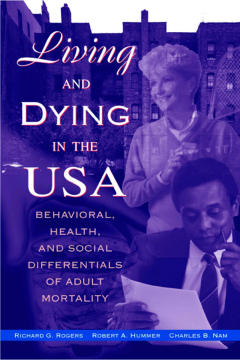
Additional Information
Book Details
Abstract
The simplicity of using one data set in addressing the relationship of single variables to mortality distinguishes Living and Dying in the USA from other recent investigations of mortality. The authors use the recently released National Health Interview Survey and the National Death Index to make a definitive statement about demographics and mortality. By surveying demographic and sociocultural characteristics associated with mortality, socioeconomic effects, health-related conditions, and health status, they reveal connections among several factors related to mortality chances. Easily understood and cited, their study emphasizes the statistical methods underlying their revelations and invites readers to duplicate their results.
- Comprehensive coverage of US adult mortality differentials
- Based on a new and innovative data set
- Includes factors rarely examined in related mortality research
- Not only documents mortality differentials, but explores explanations for them
- Extensive list of references associated with each chapter
- Consistent, straightforward methodology used throughout aids readers in both understanding the content and in comparing results from chapter to chapter
"The authors have provided an invaluable guide to the health and mortality landscape of modern America. In addition to valuable summaries of past research, they contribute a rich array of fresh results using the best available data. This study cannot be ignored by any serious scholar of demography or public health." --SAMUEL H. PRESTON, University of Pennsylvania, Philadelphia
"This book uses the annual, cross-sectional National Health Interview Surveys of adults aged 18+ who responded in 1986-94 and matches their responses to any death certificates filed on them in the Multiple Cause of Death file. It describes and explains how biological and socioeconomic factors in younger adults' lifestyles set the final stage for death in old age by specific medical causes. In these ways, it helps us understand why, even after three decades of Medicare, elderly Americans (the majority of all who die in the USA) live lifestyles in earlier stages that keep them alive longer if they have higher socioeconomic status in old age." --NAN E. JOHNSON, Florida State University, Tallahassee
"Living and Dying in the USA is a unique and valuable contribution to research on social and behavioral factors associated with mortality in the United States. Its authors are three eminent demographers who bring a wealth of relevant background and experience to bear on this analysis of mortality patterns using a single national dataset: the National Health Interview Survey matched to the Multiple Cause of Death file. The range of variables is large, from basic socioeconomic characteristics, to health insurance, mental health, smoking and drinking, and many others. The very large sample size permits certain analyses available nowhere else: for example, multivariate analysis of adult mortality by eight race/ethnic categories (including four Hispanic sub-groups), nativity, and other sociodemographic characteristics. Along with the size and power of the dataset come many intriguing findings: foreign-born African Americans have the lowest mortality of any ethnic group; net of other factors, infrequent religious attendance is consistently and significantly associated with higher adult mortality. Withal, this book is as valuable for the lines of research it suggests and the questions it leaves unanswered as for the findings it presents. It is an essential reference point for future research on adult mortality in the United States." --CONSTANCE A. NATHANSON, Russell Sage Foundation, New York "In their book Living and Dying in the USA, Drs. Rogers, Hummer and Nam set out to explore the various forces that influence mortality differentials now present in the United States. Using innovative data and methods of analysis, the authors provide a snapshot picture of the relative influence of all of the major forces that have led to observed differences in the risk of death. The effects of gender, education, smoking, health insurance, employment and occupational status, ethnicity, and even religious practices are examined with respect to how each influences mortality differentials among population subgroups. This book is by far the most comprehensive and authoritative examination of adult mortality ever conducted for a single nation. Because the language is clear, the methods of analysis easily understandable and the results easy to follow, Living and Dying in the USA is required reading for anyone interested in a scientifically valid snapshot of health and longevity in the United States at the dawn of the 21st century." --S. JAY OLSHANSKY, The University of Chicago, Illinois
"[The authors] have put together a demographer's dream by using the statistics recently made available through the National Health Interview Survey and the National Death Index. This book presents fresh data combined with death certificates to draw sociological conclusions about mortality in the United States. The authors clearly explain how they analyzed each set of data and drew their conclusions to define a particular aspect of mortality. While it is no surprise that the poor, uneducated, uninsured, and unemployed die sooner than the rich, well-educated, and insured, this remains the most comprehensive work to date on the demographics of death. The book is easily understandable and not at all hesitant about divulging the methodology used. Each chapter contains an author's conclusion and explanation. Highly recommended for academic and large public libraries." --LIBRARY JOURNAL
"...[an] engaging and potentially path-breaking book. ...A major strength of the book is the authors' thorough and systematic analysis of social and economic variables, including socioeconomic status (SES), family relations, and social and religious participation. Each chapter of the book is devoted to investigating the influence of a different set of variables on one's chances of survival. ...Although the chapters in this book devote considerable space to personal health behaviors (smoking, drinking, exercise), the authors should be commended for cautioning readers that not all risky behaviors arise from free choice. The nonrandom pattern of distribution of health behaviors according to socioeconomic status is itself a powerful reminder that one's chances of life and death are shaped by the social context." --CONTEMPORARY SOCIOLOGY
